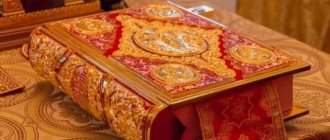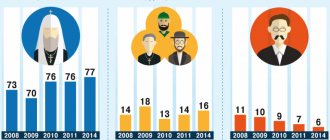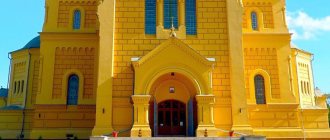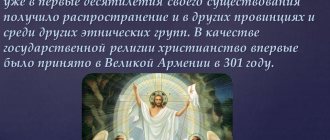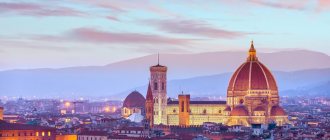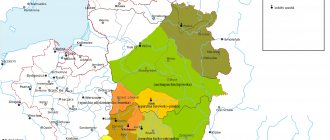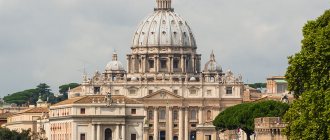In this article we will answer the question of what religions exist in Russia. Russian religion is a complex of church movements that have gained a foothold in the lands of the Russian Federation. As a secular country, Rus' is defined by the Constitution in force since 1993.
What is freedom of religion? The Constitution is the document that guarantees both the sovereignty of religion and the independence of conscience. It provides the right to profess personally or together with others any belief or not to believe in anything. Thanks to this document, you can freely popularize, choose, have religious and other beliefs, and function in accordance with them. It is known that federal law No. 125-F of September 26, 1997 “On religious coalitions and freedom of conscience” guarantees “equality before the law, regardless of views and attitudes towards faith.”
In Russia there is no special state federal body designed to monitor compliance with rules by religious organizations. It is known that in the USSR there was a Council for Religious Affairs under the Council of Ministers.
The basic faiths featured in Russia are: Buddhism, Islam and Christianity (Protestantism, Orthodoxy and Catholicism). At the same time, part of the Russian population does not believe in God.
Number of believers
What proof of God do you know? We want to tell you that the Lord does not provide evidence of his deeds: you either have deeds, or you do not have faith. In the Russian Federation there are currently no official statistics on membership in religious structures: the law prohibits asking citizens about their religious affiliation. As a result, one can talk about the fear of God of Russians only by studying the results of sociological surveys of the population.
It is interesting that the data from such events are ambiguous. Thus, in a blitz survey in 2007, the Russian Orthodox Church stated that its followers are about 120 million Russian citizens. And the leaders of Islam at the same time believed that there were from 13 to 49 million Muslims living in the country. But there are only 144 million souls in the Russian Federation! Consequently, one of the confessions significantly exaggerates its fame.
In August 2012, the Sreda service conducted an all-Russian study “Atlas of Nationalities and Religions” in 79 out of 83 constituent entities of the Russian Federation. Here's what she found out:
- 58.8 million (or 41%) residents of the Russian Federation belong to the Russian Orthodox Church (profess Orthodoxy).
- 9.4 million people (or 6.5%) believe in Islam (including Shia, Sunni and those who consider themselves neither Shia nor Sunni).
- 5.9 million (or 4.1%) residents profess Christianity, but do not consider themselves Catholics, Orthodox, or Protestants.
- 2.1 million (or 1.5%) residents profess Orthodoxy, but are not Old Believers and do not belong to the Russian Orthodox Church.
- 1.7 million (or 1.2%) consider themselves to be the classical religion of their ancestors, serving the forces of nature and various gods.
- 0.4% (or 700,000) of the inhabitants practice Buddhism (usually Tibetan).
- 0.2% (or 350,000) of people are Old Believers.
- 0.2% (or 350,000) of people call themselves Protestants (Lutherans, Baptists, Anglicans, Evangelicals).
- 0.1% or (170,000) people identify themselves with Eastern religions and spiritual practices (Hare Krishnas and Hindus).
- 0.1% (or 170,000) call themselves Catholic.
- 170,000 (or 0.1%) are Jews.
- 36 million (or 25%) people believe in the Lord, but do not identify themselves with a specific religion.
- 18 million (or 13%) do not believe in God at all.
It is known that in July 2012, the Voice of Runet service conducted a survey, which revealed that 67% of visitors to the Russian-speaking Internet are God-fearing.
A study by the Levada Center, conducted in November 2012, showed that the percentage of believers in the Russian Federation was distributed as follows:
- Orthodoxy - 74%.
- Protestants - 1%.
- Catholicism - 1%.
- Atheists - 5%.
- Refused to answer - 0%.
- Islam - 7%.
- Judaism - 1%.
- Hinduism - <1%.
- Buddhism - <1%.
- Other - <1%.
- Difficult to answer - 2%.
- To no religion - 10%.
FOM information for June 2013 looks like this:
- Orthodoxy - 64%.
- 25% do not consider themselves lovers of God.
- Other Christian denominations (Uniates, Protestants, Catholics, Baptists, etc.) - 1%.
- Other faiths - 1%.
- Islam - 6%.
- Difficult to answer, cannot name a specific denomination - 4%.
Religious composition
Let us present statistical data on the percentage of representatives of different faiths in Russia:
| Name of religious denomination | % from Levada – Center 2012 | % of the Public Opinion Foundation 2013 | % of the Russian Academy of Sciences 2013 |
| Orthodoxy | 74 | 64 | 79 |
| Catholicism | 1 | less than 1 | no data |
| Protestantism | 1 | less than 1 | no data |
| Judaism | 1 | no data | No data |
| Islam | 7 | 6 | 4 |
| Buddhism | less than 1 | no data | no data |
| Hinduism | less than 1 | no data | no data |
| Others, including traditional | less than 1 | 1 | 1 |
| Atheists | 15 | 25 | 9 |
| Difficult to answer | 2 | 2 | 7 |
*The concept of “traditional” is applied to various beliefs of the pre-Christian period: polytheism, veneration of nature, spirits and ancestors.
The table shows generalized data for the entire country. Regional statistics will depend on the national composition.
Orthodoxy
Agree, religions in Russia are widespread everywhere. Let us now try to study Orthodoxy. It is known that the Law of the RSFSR of 1990 (dated October 25) was replaced by the Federal Law of 1997 (dated September 26) No. 125-FZ “On religious coalitions and freedom of conscience.” Its introductory part contains an acceptance of the “extraordinary role of Christians in the history of Rus'.”
Orthodoxy in the Russian Federation is represented by the Orthodox Russian Church, Old Believer associations, as well as a large number of alternative (non-canonical) Christian structures of the Russian tradition.
In general, the Russian Christian Church is the largest religious association in the lands of Russia. The Russian Orthodox Church considers itself historically the first Russian Christian community: officially its state foundation was laid in 988 by Saint Prince Vladimir, according to established historiography.
According to the leader of the “Public Russian Movement”, political scientist Pavel Svyatenkov (January 2009), the Russian Orthodox Church is de facto in a special position in current Russian society and political life.
Report "The role of Orthodoxy in the history of Russia" article (group) on the topic
The role of Orthodoxy in the history of Russia.
Lopandina Nadezhda Pavlovna
Lebedyan
Russian people don’t know anything higher than Christianity, and they can’t even imagine... delve into Orthodoxy: it’s not just churchliness and ritualism, it’s a living feeling that among our people has turned into one of those basic living forces without which nations cannot live.
F.M.Dostoevsky
For more than a thousand years, the Orthodox faith has played and continues to play a key role in the development of Russian culture and the Russian state. In 988, the baptism of Rus' was carried out by the Novgorod and Kyiv prince Vladimir the Baptist (Red Sun) with the aim of forming the Russian state and strengthening it. As a result, Slavic writing, books and literacy, the latest construction technologies at that time, icon painting and fresco painting spread across Russian lands. Orthodoxy seriously softened morals and became an organic part of people's life and government, and also laid the foundation for the transformation of disparate Slavic, Finnish and Turkic tribes into a single Russian nation. The culture of Russia has historically been formed under the influence of Orthodoxy, and all its spheres are deeply connected with Orthodoxy. Historically being the core of traditional Russian culture, Orthodox culture is closely connected with the national cultures of many peoples of Russia in their historical development and modern state.
The federal “Law on Freedom of Conscience and Religious Associations” recognizes in the preamble the special role of Orthodoxy in the history of Russia, in the formation and development of its spirituality and culture. Next, it talks about respect for other faiths, which form an integral part of the historical heritage of the peoples of Russia. The “Law on Freedom of Conscience and Religious Associations” was adopted by the State Duma and approved by the Federation Council, that is, approved by all of multinational and multi-confessional Russia, which recognized the special role of Orthodoxy in its history.
Since the end of the 10th century, Orthodoxy has become the spiritual and moral core of society, shaping the worldview, character of the Russian people, cultural traditions and way of life, ethical standards, and aesthetic ideals. For centuries, Christian ethics has been regulating human relations in the family, everyday life, at work, and in public places, determining the attitude of Russians to the state, people, the objective world, and nature. Legislation and international relations also develop under the strong influence of the Orthodox Church.
Orthodoxy played a huge influence in the lives of famous commanders: Saint Prince Alexander Nevsky is an integral part of the Russian patriotic tradition.
It is a well-known fact that St. Sergius of Radonezh blessed Prince Dmitry Donskoy before the Battle of Kulikovo, and the monks of the Trinity-Sergius Lavra took part in the same battle. The Battle of Kulikovo marked the beginning of the transformation of Ancient Rus' into Great Russia.
Suvorov is the very embodiment of Russia, all spiritual and moral values and deep meanings of Russian Orthodox civilization! The civilizational code of Russia and the genetic code of its future victories are hidden in Suvorov! Suvorov’s “Science of Victory” should become the spiritual basis for the education of all Russian citizens.
If we consider the recent past, namely the mid-twentieth century, then during the Great Patriotic War the Russian Orthodox Church took an active part in the defense of our Motherland. And this is not a complete list of examples in which Orthodoxy played a big role.
The significance and influence of Orthodox culture in society is not limited to the sphere of spiritual life. Within the framework of the Orthodox cultural tradition in its historical development, a unique civilizational phenomenon was formed - the Orthodox way of life. This is the area of culture and everyday life of millions of Russians over dozens of generations, interpersonal and civil relations, stable stereotypes of social behavior that have become an integral part of Russian reality. Most of our national cultural heritage, expressed in the material culture of the Russian people, is historical buildings and structures, material monuments of history and culture, objects of everyday life and production, folk art, art, etc. belong to Orthodox culture or bear its imprint.
In the moral field, Orthodoxy gave the Russian people a living and deep sense of conscience, a dream of righteousness and holiness. Hence the spirit of mercy and nationwide, classless and supra-national brotherhood characteristic of the Russian people, sympathy for the poor, weak, sick, oppressed and even criminals, hence our almshouses, hospitals and clinics, created with private donations. Orthodoxy fostered in the Russian people that spirit of sacrifice, service, patience and fidelity, without which Russia would never have defeated its enemies and would not have built its earthly home.
2016 is the year of the millennium of Russian Athos. Russian Athos is an inextricable and important component of the heritage of the Holy Mountain in Greece as a universal treasury. The influence of the Holy Mountain on the spiritual development of Rus' played a decisive role throughout its thousand-year history. Speaking about Russian Athos, one cannot fail to mention one of the greatest saints of the 20th century - St. Silouan of Athos. This year the Orthodox world will celebrate the 150th anniversary of the birth of the holy ascetic. A prayer book for the whole world, the brightest lamp of the Holy Mountain of the past century, the Venerable Schemamonk Silouan was born in Russia, in the family of a pious peasant Ivan Antonov in the village of Shovskoe. Long years of spiritual life on Mount Athos made him a great ascetic. “A will of rare strength - without stubbornness; simplicity, freedom, fearlessness and courage - with meekness and gentleness; humility and obedience - without humiliation and people-pleasing - this was truly a man, the image and likeness of God,” wrote the elder’s student and biographer, Archimandrite Sophrony Sakharov.
The Monk Silouan of Athos became one of the spiritual representatives for Russia, which at that difficult time was going through an era of terrible persecution of the Church of Christ.
| Russian historian Nikolai Ivanovich Kostomarov wrote: The barbaric structure of social life changes with the adoption of the Christian religion, with which from Byzantium - the most educated power in those days - both legal and state concepts, as well as the beginnings of intellectual and literary activity, came to us. The adoption of Christianity was a revolution that renewed and revitalized Rus' and showed it the historical path. |
Popularization of Orthodoxy in Russia
How common are religions in Russia? In March 2010, VTsIOM conducted an all-Russian survey, according to which 75% of residents consider themselves Orthodox Christians. It is noteworthy that only 54% of them studied the Bible, about 73% of Christians observe religious tenets.
Mikhail Askoldovich Tarusin, who holds the post of head of the sociological department of the Institute of Collective Design, believes that this information shows absolutely nothing. He said that these data are only indicators of Russian modern national identity. If we consider those who take part in the sacraments of communion and confession at least a couple of times a year as Orthodox people, then their total number is 18-20%.
Analysts believe that opinion polls show that the overwhelming number of believers call themselves Orthodox on the basis of national unanimity.
Let's consider the topic through the prism of the law
Freedom of religion in Russia is constitutionally enshrined. Citizens decide for themselves what exactly to believe in and which churches to visit. You can also always remain an atheist and not support any of the faiths. And there are a lot of them on the territory of the country: according to the latest data, seventy religious denominations have been identified that are actively operating in the state. Based on this, we can safely conclude that the issue of religion in Russia is not a pressing issue. Believers respect each other's rights and freedoms without encroaching on alien religious traditions.
At the legislative level, there is a ban on insulting the feelings of believers and committing actions that can be interpreted as disrespect for them. Criminal penalties are provided for such acts.
This attitude towards religion ensures the inviolability and immutability of freedom of religion in Russia. Many scientists believe that this is historically predetermined. After all, our country has always been a multinational state where conflicts based on religious hatred have never arisen. All nations and peoples have respected each other's rights and beliefs for many centuries. This situation continues to this day.
However, many are interested in what religion in Russia can be considered the most important? Let's look for the answer to this question together in the following sections of the article.
Catholicism
So, does the Lord exist or not? Can anyone provide any proof? No one has seen God. And yet, historically, Latin Christianity was present in the lands of the Eastern Slavs from the birth of Kievan Rus. Very often, the rulers of the Russian state changed their attitude towards Catholics: they either rejected them or accepted them favorably. Today the Catholic community of Rus' includes several hundred thousand believers.
We know that the October Revolution took place in Russia in 1917, but Catholic churches continued to operate freely for some time. And yet, in the 1920s, Soviet power began to eradicate this faith in Russia. During those troubled times, many Catholic priests were shot and arrested, almost all churches were looted and closed. Many active parishioners were repressed and exiled. In the RSFSR after the Great Patriotic War, only two Catholic churches operated: Our Lady of Lourdes (Leningrad) and St. Ludovika (Moscow).
The image of Christ did not leave Rus', and since the early 1990s, Catholics have resumed their activities in Russia. Two Apostolic Catholic Directorates of the Latin Rite, a College of Catholic Theology and a Theological Higher Seminary appeared.
The Federal Registration Service reported in December 2006 that there are about 230 parishes in Russia, a quarter of which do not have church buildings. The parishes consist of four dioceses, united together into a metropolitanate.
In 1996, there were between 200 and 500 thousand Catholics in Russia.
Dynamics by year
If we compare the dynamics of changes in the number of Orthodox Christians and Muslims in Russia, we obtain the following data (Levada Center):
- From 2009 to 2012, the number of Muslims in Russia grew from 4% to 7%, and in 2021 it was approximately 14%.
- The number of Orthodox residents of Russia declined over the same period: from 80% in 2009 to 74% in 2012.
Protestantism
R. N. Lunkin estimates the number of Protestants in Russia at three million people (2014). He reported that over half of them are members of a large number of Pentecostal and neo-Pentecostal churches. Other major Protestant denominations include tens of thousands of believing citizens: Baptists, Lutherans, Evangelical Christians and Adventists.
In terms of the number of religious organizations officially registered by the Ministry of Justice, Protestants in the country are in second place, second only to the Orthodox. By the way, Protestants in the Volga and North Caucasus federal districts are also inferior to Muslims, and in the Far Eastern district they take first place.
Others
The image of Christ is also revered by Jehovah's Witnesses. Their number in Russia in 2013 averaged 164,187 active preachers. It is known that about 4,988 Russians were baptized in 2013, becoming Jehovah's Witnesses. 283,221 people attended the Memorial in 2013. In Rus' there is also spiritual Christianity, which includes the Molokans and Doukhobors.
Content
- 1 Total number of believers
- 2 Christianity 2.1 Orthodoxy 2.1.1 The prevalence of Orthodoxy in Russia
- 2.1.2 Orthodox observance of church rites
- 2.5.1 Jehovah's Witnesses
- 3.1 Religious organizations and leaders
- 9.1 Clericalization
Islam
The names of the gods of the ancient world are almost forgotten. Today in Russia about 8 million people profess Islam. The Muslim Spiritual Administration of the European part of the Russian Federation claims that about twenty million followers of Islam live on the territory of this country.
The vast majority, of course, call themselves “ethnic” Muslims. They do not fulfill the requirements of the religious doctrine and consider themselves to be part of it due to traditions or place of residence (Tatarstan, Bashkorostan). In the Caucasus, communities are very powerful (the Christian region of North Ossetia is an exception).
Many Muslims live in the Volga-Ural region, St. Petersburg, Moscow, the North Caucasus and Western Siberia.
Temples and churches
The main spiritual center for Russian people professing the Orthodox faith can be considered the Moscow Cathedral of Christ the Savior (restoration was completed in 1999, capacity 10 thousand people). For Muslims, conditionally, the main one can be considered the Moscow Cathedral Mosque (accommodates 10 believers). But the Central Juma Mosque in Dagestan (17,000 seats) and the Aimani Kadyrova Mosque in Chechnya (can accommodate 15,000 people) should be highlighted.
The most significant ancient Orthodox churches and monasteries (active):
- Sophia Cathedral in V. Novgorod (foundation - mid-11th century).
- Pskov-Pechersky Monastery (Pskov diocese, founded in 1473).
- Yuryevsky Monastery (one of the oldest - 1030).
- The Annunciation Iono-Yashezersky and Spaso-Preobrazhensky monasteries are located on the territory of Karelia (the second was recognized as the property of the peoples of Russia by presidential decree of 1992).
Below is information on the total number of temples, mosques and synagogues in Russia:
- Orthodox - 38,649. Monasteries - 474 male and 498 female.
- Catholic - approximately 320.
- Protestant - about 10,000.
- Mosques – 7000.
- Synagogues – 34 (FEOR).
*Since 1980, the number of mosques in Russia has increased from 700 to 7000 (information as of 2021, according to the chairman of the Council of Muftis of the Russian Federation).
Judaism
Agree, the religions of peoples are very interesting to study. Let's find out how many people in the Russian Federation revere Judaism. In total there are 1.5 million Jews in Russia. The Federation of Jewish Russian Communities (FEOR) reports that 500 thousand Jews live in Moscow, and about 170 thousand live in St. Petersburg. There are about 70 synagogues in Rus'.
Simultaneously with FEOR, another major alliance of Jewish religious communities operates - the Congress of Spiritual Jewish Associations and Organizations of Russia.
The 2002 census states that 233,439 Jews officially live in Russia.
Buddhism
Beliefs and religion can be studied endlessly. For which regions of the Russian Federation is Buddhism traditional? It is common in Buryatia, Kalmykia and Tuva. The Buddhist Association of Russia estimates that the number of people who worship Buddha is between 1.5 and 2 million.
In general, the number of “ethnic” Buddhists in Rus' (according to information on the 2012 population census) was: Kalmyks - 174 thousand people, Buryats - 445 thousand, Tuvans - 243 thousand people. In total, about 900 thousand souls traditionally identify themselves with Tibetan Buddhism of the Gelug school.
In the 1990s, Zen and Tibetan Buddhism gained enormous popularity among the urban intelligentsia. In those days, even corresponding communities appeared.
The world's northernmost Buddhist church is located in St. Petersburg. It was erected even before the revolution in Petrograd (“Datsan Gunzechoiney”). Today this building is a tourist and religious center of Buddhist culture.
Orthodox Church in Russia
In Russian history, starting from the baptism of Rus' in the 10th century, the church was associated with state power. And church leaders (initially metropolitans, and from 1589 patriarchs) were always part of the tsar’s inner circle. Orthodoxy was the dominant denomination.
For more than four centuries, Russians lived under the unspoken rule of the Byzantine Church. However, the Moscow church claimed its own exclusivity, and in 1448 the Moscow priests declared their own independence, not recognized by Constantinople and the rest of the world in general. And after another 140 years, the new church had an official head - the patriarch.
With the fall of the monarchy, a period of testing began for the Russian Church. With the beginning of the revolution in Russia, a policy of forcibly imposing atheism unfolded. The result was the looting of many temples.
State pressure on the church weakened in the last months of 1941, after a series of military failures by Soviet troops in the war with Germany. The war of 1941–1945 united believers and non-believers.
After the collapse of the USSR in 1991, the Russian Orthodox Church began to revive, and at the same time, the persecution of believers, widespread in Soviet times, ceased. The revival of the old ones began (about 1.5 thousand survived out of the 50 thousand that existed before the 1917 revolution) and the construction of new Christian churches.
Other religious forms and paganism
The existence of God has not been proven by science, but the indigenous inhabitants of the Far Eastern and Siberian regions, along with the officially professed Orthodoxy, preserve the nuances of traditional love of God. Some Finno-Ugric peoples (Udmurts, Maris and others) also honor ancient beliefs.
Their beliefs depend on the preservation of the traditional element and are characterized as folk Orthodoxy or shamanism. By the way, the term “folk Orthodoxy” can also be used in relation to the majority of Russians, especially rural ones.
The names of the gods work miracles. Therefore, many peoples of Russia are trying to revive traditional beliefs. In 2013, the experimental service “Sreda” determined that 1.5% of Russians call themselves pagans. It is interesting that all religious movements of this kind are designated as “neopaganism.”
And in the urban environment, in addition to established beliefs, the latest religious movements of the eastern (Tantrism, etc.), occult and neo-pagan (Rodnoverie, etc.) sense are flourishing.
State religion
Russia is a secular state; no religion can be recognized as a state religion at the official level. Orthodoxy has been part of the country's national ideology since the unification of the Russian principalities into a single Moscow kingdom.
After the revolution of the seventeenth year and the transformation of the Russian Empire into the Soviet Union, it lost its importance at the state level. At the same time, for a significant part of the population, established religious traditions have been preserved. It was Orthodoxy that became the main religion for most of the peoples of the country for a number of reasons:
- The backbone of the Russian Empire consisted of Russian principalities with an Orthodox majority.
- Further expansion of state borders led to the absorption of a number of small national entities.
- Gradually, the local population began to mix with the main titular nation of the empire - assimilation. The process developed at the ethnic and cultural levels.
- A number of small nations retained traditional beliefs (in nature, ancestors, polytheism) for a long time. Such directions did not have a well-developed theoretical basis, and therefore were quickly replaced by Orthodoxy, as a more structured teaching.
- Many countries that became part of the empire later initially chose Orthodoxy as their main faith (Example: religion of Georgians, Armenians).
- The annexation of large nations that did not have statehood into the country (the Orthodox majority of the population of modern Ukraine did not then have their own state).
The key factors in the formation of Orthodoxy as the state religion of the Russian Empire are listed. The cultural assimilation of a number of peoples retained the significance of this direction of Christianity after the loss of state status.
Religion is the basis of the ethics of relationships between people in society, between an individual and the state. This is laid down on a subconscious level, forming traditions and norms of life. These reasons create the opportunity for Orthodoxy to return to the status of the state religion of Russia at the official level.
The majority of the population will likely support such an issue in a referendum, if one takes place. But there are risks: many small nations in the country profess other faiths. Singling out any one religion can lead to interethnic conflicts and separatism of individual territories.
State and religion
Freedom of religion is the greatest value in any country. According to the Constitution, the Russian Federation is a secular country in which no religion can be compulsory or state. In the modern Russian Federation, the dominant trend is the clericalization of the country - the gradual creation of a model with a dominant religion.
In practice, in Russia there is no clear demarcation line between the state and religious doctrines, after which state life ends and confessional life begins.
By the way, V. Kuvakin, a member of the RAS Commission for Combating Falsification of Scientific Experiments and Pseudoscience, believes that the current leadership of Russia is making a huge historical mistake by trying to turn Orthodoxy into the state religion. After all, such actions are contrary to the Constitution.
Clericalization
We all know that the Creator of the Universe is great! Religion penetrates into all spheres of public life. It can also be found in those areas that, according to the Constitution, are separated from faith: in schools, the army, government agencies, science and education. It is known that the State Duma agreed with the Moscow Patriarchate to conduct preliminary consultations on all points that raise doubts. In schools in the Russian Federation, students began to study the basics of religious cultures; in some universities in the country there is a specialty in theology.
A new position was introduced into the staffing table of the Armed Forces - chaplain (military priest). A huge number of departments, ministries, and government agencies own their own churches. Very often these ministries have public councils that cover religious topics.
Orthodoxy is a traditional religion
The customs and traditions of the Russian people are closely related to the following phenomena:
- Calendar.
- Church sacraments.
- Holidays.
- Difficult rituals.
At the same time, popular Orthodoxy combines Christian and pagan principles. Many of the traditions are based on information that is present in the Holy Scriptures. For example, this applies to Easter and Christmas.
Weddings, expectancies and infant baptism are customs that are closely connected with the daily life of Christians. Until now, many mothers believe in signs that appeared a long time ago.
Speeches by Orthodox Christians often become a stimulus for communication on the morality of certain actions. The state tries to respond to such events and steps and does not leave them unattended.
Religious organizations are associated with a significant volume and variety of socially significant activities . Many of the areas of such work require active participation from the state, although some projects are associated exclusively with personal initiative.
The main thing is to remember that such interaction is built on the basis of respect for representatives of a particular faith and their attitudes. We must remember that the position of the Church is not always connected with national projects and their further development.
Local government bodies often take into account the multi-confessionalism characteristic of the modern Russian Federation. Support is provided precisely to those areas whose representatives are most numerous on the territory of a particular subject. Relationships are either positive or tolerant. Although Orthodoxy is still recognized as the main confession.
Let us not forget about the small indigenous peoples who also do not give up their own religions.
The state of the Russian Federation is recognized only as secular. This means that no single religious movement can have a dominant role. It is believed that the so-called clericalization of the country is one of the main trends over the past few years. That is, the model with the dominant religion is still being implemented, albeit gradually.
Religion tries to penetrate into all spheres of public and private life. This even applies to science and education, schools. For example, the State Duma is already agreeing with the patriarchy on consultations on all issues that raise doubts. In Russian schools, more and more subjects are taught that are somehow related to religion.
It is reported that the new courses were not created to force schoolchildren into religious life. It only emphasizes that familiarity with the basics of religion is useful, including for those who adhere to a different faith. But there were also opponents who spoke about the need to maintain a secular character for education.
Additionally, it was prohibited to use textbooks in these courses, since their content was considered unacceptable. But the creation process itself was initially planned to be transferred only to confessions; scientists have distanced themselves from this.
In Armenia, the majority of residents also consider themselves Orthodox believers. Christianity began to develop here in the 1st century AD. Faith and everything connected with it has become an integral part of the inhabitants of this country.
Reference! A movement called neo-paganism deserves special attention. It is also called Getanism.
Armenia
Now let's study the religion of the Armenians. What is it? It is known that most of the inhabitants of Armenia are Christians who call themselves adherents of the Armenian Apostolic Church. Christianity appeared in this country in the 1st century AD. e. It was then that Christ’s apostles Bartholomew and Thaddeus, who are considered supporters of the Apostolic Armenian Church, preached here.
It is known that at the beginning of the 4th century (the traditional date is 301), King Trdat III declared Christianity the state religion. This is how Armenia turned into the first Christian state on Earth.
Faith and Orthodoxy are an integral part of the life of almost every Armenian. Thus, the 2011 census of residents of Armenia states that Christianity of various denominations in the state is professed by 2,858,741 souls. This figure indicates that this country has 98.67% God-fearing population.
The religion of Armenians is not the same: 29,280 believers worship the Armenian Evangelical Church, 13,843 - the Armenian Catholic Church, 8,695 consider themselves Jehovah's Witnesses, 7,532 call themselves Orthodox (Chalkadonites), 2,872 - Molokans.
By the way, the Apostolic Armenian Church is among the Orthodox Oriental churches. These include: Coptic, Eritrean, Ethiopian, Malankara and Syrian.
World Christianity. Part 1. Russia and the Slavs.
Eastern Europe is the ancient spiritual domain of Christianity. But this does not serve the mutual understanding of peoples.
The number of Orthodox Christians is growing
Catholicism and Orthodoxy are practiced by the majority of Eastern Europeans. Moreover, according to experts, the number of Orthodox Christians is growing. In the period from 1991 to 2021, in Russia the number of Orthodox citizens increased from 37% to 71%, in Ukraine - from 39% to 78%, in Bulgaria from 59% to 75%. At the same time, there are fewer Catholics in a number of countries. For example, in the Czech Republic their number decreased from 44% to 21%, in Hungary from 63% to 56%, in Poland from 96 to 87%. But this does not always mean that people who have ceased to be Catholics have converted to Orthodoxy. Rather, the number of atheists and supporters of destructive cults has increased. In my opinion, what is important is not the rivalry of confessions, but the affiliation of people with Christianity in general. Even the most progressive Church is better than Satanism or atheism. As an example, the Czech Republic, where the number of Catholics has decreased by half, has turned into an oasis for sexual minorities. But there is another extreme, Hungary, where the president, who won thanks to Christian rhetoric, covers up corruption and disparages the independent press. But let's not judge our neighbors, let's just look at how our neighbors live.
Poland: missionary work and the coronation of Christ If in Russia the popular statement is: Russian means Orthodox, then in Poland they believe: Pole means Catholic. Concerned about the decline in religiosity in society, Polish priests are going to the people. They decided to wait for atheists on the street benches every Friday evening in order to turn their hearts to Christ. The tactic is correct, because it is precisely this that helps the sectarians replenish their ranks. So why don’t representatives of traditional faiths also turn to passers-by and ask: “Do you believe in God?” One of the initiators of the action, Catholic priest Michal Misiak, noted that each conversation will be confidential, like a confession. “We want to talk about ordinary needs, people's problems, the place of God in life, spirituality and doubts that can relate to various aspects of life. We understand that today it is not enough to wait for people in the parishes. We must go to them where they are. Encourage conversation and discussion of issues that may be important to them,” explained Father Michal.
Interesting fact, last year the coronation of Jesus Christ as King of Poland took place in Krakow. The presence of the country's President Andrzej Duda at the event confirmed the official status of the event. This act of Polish believers was dictated by concern for the fate of the country and the hope that Christ would be merciful to his kingdom. The idea of the coronation of the Son of God appeared at the beginning of the 20th century. One pious woman heard a voice from above that it was necessary to elevate Christ to the Polish throne in order to save Poland from future disasters. This thought resonated in the hearts of all Polish Christians.
And in June, for the 22nd time, a meeting of young Christians took place at Lake Lednica near the city of Gniezno, where the Epiphany of Poland took place in 966. 85 thousand young men and women from Poland and neighboring countries took part in the religious festival. Orthodoxy in Poland is the second largest denomination. Recently, the first Orthodox church in the last 100 years was built in Warsaw. This majestic building is dedicated to Sophia the Wisdom of God and is somewhat reminiscent of the famous cathedral in Istanbul. But in those same May days, news came out: a pagan temple would be built in Wroclaw. The initiators of the project do not hide the fact that magical rituals and holidays will be held there. This means that Christian preaching should sound more often and more persistently in Polish society.
Ukraine: autocephaly and liberal temptations
Ukraine, choosing the European vector of development, found itself in a difficult situation. On the one hand, it is ready to follow the lead of Western countries, on the other, it does not intend to deviate from traditional values. The West offers her the same thing that other countries in Eastern Europe offer: along with fair elections, the ability of the nation to influence the government, freedom of speech and mass protests, they impose gay parades, same-sex marriage, juvenile justice and other phenomena that are unacceptable to the majority of Ukrainians. Will Ukraine be able to choose from the gifts of Europe those that suit it? The problem is that accepting these quirks is a condition for supporting Ukraine during a difficult period. Why, according to the West, are men in pink boas eager to adopt children and other exotic things an additional addition to democracy?
On June 2, the National Day of Prayer took place in Ukraine, in which about 10,000 Christians of different denominations took part. Gathering at the Kiev Sports Palace, they offered prayers for various needs of the country. On the same day, the annual All-Ukrainian procession took place along the central streets of Kyiv under the slogan: “Happy family - healthy Ukraine!” It called on the authorities to raise the level of state family policy, and also spoke out against abortion and divorce, and asked to support the inclusive education of disabled children and the development of infrastructure for families with children. Also, the participants of the action expressed disagreement with the legislative promotion of the ideas of gender ideology, which distorts the concept of “sex.” Representatives of Christian denominations, Muslim and Jewish communities took part in the procession. Autocephaly is a topic of concern to the hierarchs of the Ukrainian Churches and the Russian Orthodox Church; in my opinion, it is almost indifferent to ordinary believers on both sides of the border. Publicists write fiery articles for and against, but ordinary priests and parishioners remain silent. For my articles, I periodically take comments from priests on current topics. The question about autocephaly was also asked to no less than ten priests. Some answered that they had not thought about or were not interested in this issue. Some remained silent. Two said two phrases each. Where does this indifference come from? I think neither Russian nor Ukrainian priests consider this issue to be pressing. Indeed, it is more political than religious. The church is part of the state system. And while the Ukrainian Orthodox Church belongs to the Moscow Patriarchate, it is by default an instrument of the Kremlin, just like the Russian Orthodox Church. But this aspect worries officials and hierarchs more than ordinary believers, who in any case will pray to Jesus Christ.
Recently, the Ukrainian Orthodox Church organized a poll on Facebook: how do Ukrainians feel about the gay pride parade that LGBT representatives are planning to hold in Kyiv? Almost all respondents expressed their disagreement with this action, many left negative comments: “Ukraine is not Sodom!”; “Why parades? Everyone already knows about their existence. I think this is being done to attract young people into their ranks. And this is already bad. That’s why I am “against””; “During the war, this is Ukraine’s biggest problem? Let them go together and pave the roads in the Kherson region”; "Of course yes"! If the march takes its organizers and participants irrevocably beyond the borders of Ukraine!”
For the third month now, an appeal from former drug and alcohol addicts in Ukraine has been disseminated on social networks, directed against the country’s law enforcement agencies. Its title is “Don’t save us like that!” Citizens are protesting against the pogroms of Christian rehabilitation centers, where drug addicts and alcoholics are returned to the true path. By dispersing these organizations, law enforcement officers believe that they are freeing people from “slavery,” where they are held by force by reading sermons. In fact, on the street, the unfortunate people return to the slavery of their vices and disappear one by one.
Russia: contemporary Orthodoxy
The Russian Orthodox Church, caring for a huge country, tries to pay attention to all social groups. Priests communicate via the Internet and conduct video blogs. Christians support the disabled and homeless, engage in prison ministry, and think about environmental issues. Orthodoxy is relevant - the slogan of our time. This religion will help you cope with any tasks and answer all questions.
Currently, a methodology for interaction between the priesthood and HIV-infected people is being developed. It cannot be assumed that they are all victims of their own vices, since there are cases when people became victims of HIV even in hospitals. Some were infected by spouses who were drug addicts or fornicators. Among HIV-infected people there are also children of mothers who led an antisocial lifestyle. In any case, treating suffering people requires humanism. Alexey Lazarev, head of the department of assistance to drug addicts of the Synodal Department for Charity, explains: “We need to eliminate the blind spots, of which, unfortunately, there are a lot. Due to poor awareness of clergy about what HIV is, unpleasant situations often arise, due to which infected people cannot receive communion and become outcasts in their parish. We plan, together with doctors, to begin developing methodological recommendations for clergy on the pastoral care of people with HIV-positive status.” The creators of the methodology note the danger of HIV dissidence, which occurs among clergy. Some pastors simply deny the existence of a dangerous disease. But a frivolous attitude towards HIV infection jeopardizes the health of parishioners who trust such confessors.
A representative of the counterculture, director Valeria Gai Germanika surprised the Russian public with her Orthodox missionary work. She decided to launch the media project “Faith in the Big City” on YouTube. Gai Germanika explained that in her program she will talk about how to combine modern life and Christianity. The director will invite “opinion leaders” from the business environment, the media sphere and the art world to participate in the program.
On July 15-22, with the blessing of His Holiness Patriarch Kirill of Moscow and All Rus', the youth volunteer forum “Good Summer” -2018 will be held. Its goal is to unite young Russians who strive to live and do good deeds in accordance with Orthodox beliefs. But the estimated number of participants seems small to me for Russia - 1000 people.
Terrorist attacks by Islamic radicals against parishioners of Orthodox churches lead to official meetings of Christian and Muslim clergy, pondering how to prevent such tragedies? Whereas the active attraction of Muslims to Orthodoxy would be of great benefit. But such work is not being done.
The big picture
Attitudes towards abortion, gender and sexual minorities characterize the religiosity of a society. The American research organization Pew Research Center conducted a study on this topic in Eastern Europe. Its results show that adults in predominantly Orthodox countries are less supportive of abortion rights in all circumstances. Thus, 64% of Russians, 65% of Ukrainians, 58% of Belarusians are against it. In Serbia, only 37%, which indicates a decline in religiosity.
But traditionalism is not always a panacea for evil. Selective abortions have almost become fashionable in Montenegro. In both Muslim and Christian settlements, women do them at the insistence of their husbands, getting rid of female embryos. Here the desired children are sons. “We are a nation of warriors, families need boys.” - Says an elderly Montenegrin. As a result, there are fewer girls in the country. Don't be surprised if there's a sizeable gay community here in ten years.
The perception of patriarchal attitudes by modern men and women is curious. So to the question: “Should a wife submit to her husband?” 36% of Russians, 41% of Ukrainians, 43% of Belarusians, 31% of Bulgarians, 34% of Serbs answer affirmatively. But it is worth noting that we do not know which gender of respondents most often chose this answer. As in the survey on the topic: “Do you think that a woman’s duty to society is to give birth to children?” 59% of Russians, 59% of Belarusians, 65% of Ukrainians, 69% of Serbs agreed with this.
According to Pew Research Center observations, homosexuality is considered morally unacceptable by 85% of Russians, 83% of Ukrainians, 85% of Belarusians, 69% of Serbs, 58% of Bulgarians, 48% of Poles. By the way, the Synod of the Bulgarian Orthodox Church is currently protesting against the gay pride parade, which is scheduled for July. Registration of same-sex marriages is supported by 12% of Russians, 18% of Ukrainians, 36% of Belarusians, 30% of Serbs. But these numbers are hard to believe, especially about Belarus. Aren't they overstated?.. * * * The problems of Eastern European Christianity are reminiscent of Western ones, but they also have their own specifics. Especially in Russia, Ukraine and Poland.
— Politicization of religion, when governments drag church hierarchs into their disputes. Priests bless participants in military conflicts on both sides of the front and do not stop parishioners who intend to participate in the war.
— Tense relationships between Christian denominations, when everyone considers each other “wrong” Christians, heretics. Lack of dialogue and joint projects for the benefit of society.
— Discord over churches, which communities take away from each other in Ukraine, sometimes leading to assault.
— Debates in society over church buildings that the Russian Orthodox Church is trying to regain.
— Lack of missionary work among disadvantaged youth.
— Lack of missionary work in the Muslim environment.
— Passion for magic and paganism, when even priests talk about karma in blogs.
— An attempt to glorify dubious “saints,” sometimes for political reasons.
Many believers, making Christianity a handy tool in solving earthly problems, have no idea what their actions would look like from the point of view of Christ. What if the Son of God appears now, when heads of state and intelligence agencies are swindling their affairs, hiding behind discussions about faith? When does one Christian call another a heretic or schismatic, as if he has the right to judge? When one Orthodox Christian shoots at another and both are convinced that they are right? And journalists with crosses on their necks pour slop on neighboring Christian nations? Before you do something important, just, in your opinion, think: will Christ agree with you?
Subscribe to our channel in Yandex.Zen!
Click “Subscribe to channel” to read “Tomorrow” in the Yandex feed
Yezidism
It is known that freedom of religion also exists in Armenia. This country is home to 25,204 adherents of Yazidism (almost 1% of the state's devout population). These are mainly Yazidi Kurds. They live in villages in the Ararat Valley, a little northwest of Yerevan. On September 29, 2012, the Ziarat Temple was inaugurated in the Armavir region of the state.
It is considered the first temple built outside of Northern Iraq, the original homeland of the Yazidis. Its task is to satisfy the spiritual needs of the Yezidis of Armenia.
Islam
We have examined the Christian religion of Armenia. Who in this country welcomes Islam? It is known that this creed is practiced here by Kurds, Azerbaijanis, Persians, Armenians and other peoples. A mosque was built specifically for Muslims in Yerevan.
Today in this state the Muslim Kurdish community includes several hundred souls, most of whom live in the Abovyan region. Some Muslim Azerbaijanis live near the northern and eastern borders of Armenia in villages. In general, there are about one thousand Muslims in Yerevan - Kurds, people from the Middle East, Persians and about 1,500 Armenian women who converted to Islam.
Neopaganism
Aren't you tired of studying the endless religions of peoples? So, we continue to further analyze this interesting topic. The 2011 census shows that there are 5,434 pagan supporters living in Armenia.
The neo-pagan religious movement is called Getanism. It recreates the established Armenian pre-Christian dogma. Getanism was founded by armenologist Slak Kakosyan on the basis of the writings of Garegin Nzhdeh, the most famous Armenian nationalist.
All neo-pagan sacraments are constantly carried out in the Garni temple. The head of the Armenian pagan communities is the priest Petrosyan Zohrab. No one knows the specific number of followers of this faith. In general, Armenian neo-paganism is popular, as a rule, among fans of ultra-right and nationalist movements.
It is known that well-known Armenian politicians considered themselves titanists: Ashot Navasardyan (founded the ruling Republican Armenian Party) and Margaryan Andranik (former prime minister of the country).
Freedom of belief in Russia
The convictions and religion of the Russian people prompted Emperor Nicholas II in 1905 (April 17) to issue a personal imperial decree for the Senate. This decree spoke about strengthening the origins of religious tolerance. It was this paper that for the first time in the history of Rus' legislated not only the rights to freedom of belief of persons of non-Orthodox faith, but also established that leaving it for other faiths is not subject to persecution. Additionally, the tsar legalized the Old Believers and abolished previously existing prohibitions and restrictions for other Christian denominations.
The Law on Religion states that religion has been a personal matter in Russia since January 20, 1918. This is exactly what the decree of the Council of People's Commissars of the RSFSR proclaimed.
And the Constitution of the Russian Federation (Part 2, Article 14) says that:
- Russia is a secular country. No religion here can be established as compulsory or state.
- Religious communities are separated from the state and are equal before the law. The Federal Law “On Religious Coalitions and Freedom of Conscience” in 1997 recorded “the exclusive role of Orthodoxy in Russian history, in the formation of its culture and spirituality.”
We hope this article helped you get a general idea of Russian religions.
History of Orthodox Christianity in Russia
Russia professes a special form of Christianity - Orthodoxy (there are more than 80% of Orthodox believers in Russia). This movement arose at the moment when the Roman Empire, which recognized Christianity as the state religion, was divided into Western and Eastern. The Eastern part had its own church head - the Patriarch of Constantinople. Formally subordinate to the Pope, the Constantinople church elite actually had their own, special view on the principles of church structure - but simply, they wanted to govern the eastern part of the world themselves, without the intervention of the Pope. After the Western Church made a small addition to the Christian Creed about the procession of the Holy Spirit not only from God the Father, but also from God the Son, the Pope and the Patriarch of Constantinople simultaneously anathematized each other. The famous division of churches into Catholic and Orthodox took place.
The history of the emergence of Christianity in Rus' is known to everyone: the great Russian principality simply decided to establish closer contacts with Byzantium, that is, the Eastern Roman Empire and adopted Orthodoxy.
So what is the difference between the Orthodox Church and the Catholic Church? Let's name the main features... The first difference is the different understanding of the unity of the church. For the Orthodox it is enough to share one faith and sacraments; Catholics, in addition to this, see the need for a single head of the church - the Pope.
By the way, the Orthodox do not recognize the primacy of the Pope at all. Whereas Catholics accepted the dogma of the entire dogma of the Pope over the church.
Another difference in the Creed. The Catholic Church confesses in the Creed that the Holy Spirit proceeds from the Father and the Son. The Orthodox Church professes the Holy Spirit, which comes only from the Father.
The Catholic Church also accepted the dogma of the Immaculate Conception of the Virgin Mary. This means that even original sin did not touch the Mother of the Savior. Orthodox Christians glorify the holiness of the Mother of God, but believe that she was born with original sin, like all people.
The Orthodox Church accepts the decisions of only the first seven Ecumenical Councils, while the Catholic Church is guided by the decisions of the 21st Ecumenical Council.
Despite their differences, Catholics and Orthodox Christians profess and preach throughout the world one faith and one teaching of Jesus Christ.
